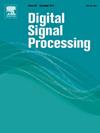Design and analysis of grouping five-dimensional index modulation for high data rate DCSK communication system
IF 2.9
3区 工程技术
Q2 ENGINEERING, ELECTRICAL & ELECTRONIC
引用次数: 0
Abstract
In this paper, a new index modulation system termed grouping five-dimensional index modulation differential chaos shift keying (G5DIM-DCSK) is proposed, which is intended to provide ultra-high data rate transmission based on grouping technique. This system uses five different types of index sources: subcarrier, time slot, permutation chaos, Walsh code, and permutation code. There is an equal distribution of mapping and modulating bits among the G groups formed by the input information bits. In all time slots and active subcarriers, the modulating bits are sent via either the chaotic reference sequence or the permutation chaotic reference, which is chosen by the permutation chaotic index bits. The Kronecker product of a chaotic signal and the first row of the Walsh coding matrix yield the chaotic reference sequence. In the unselected time slots and inactive subcarriers, the modulating bits are carried by a sequence created by the Kronecker product between the chaotic signal and the selected row of the Walsh code matrix. This operation is completed by permuting the selected Wlash codes using the permutation code index bits. Our examination looks at the system's information rate, spectral efficiency, and complexity, comparing them to similar systems. Furthermore, the analytical BER for the G5DIM-DCSK system under multipath Rayleigh fading channels and additive white Gaussian noise (AWGN) is derived. Simulation results not only support the performance analysis, but also show that the proposed system outperforms similar systems under equivalent conditions.
求助全文
约1分钟内获得全文
求助全文
来源期刊

Digital Signal Processing
工程技术-工程:电子与电气
CiteScore
5.30
自引率
17.20%
发文量
435
审稿时长
66 days
期刊介绍:
Digital Signal Processing: A Review Journal is one of the oldest and most established journals in the field of signal processing yet it aims to be the most innovative. The Journal invites top quality research articles at the frontiers of research in all aspects of signal processing. Our objective is to provide a platform for the publication of ground-breaking research in signal processing with both academic and industrial appeal.
The journal has a special emphasis on statistical signal processing methodology such as Bayesian signal processing, and encourages articles on emerging applications of signal processing such as:
• big data• machine learning• internet of things• information security• systems biology and computational biology,• financial time series analysis,• autonomous vehicles,• quantum computing,• neuromorphic engineering,• human-computer interaction and intelligent user interfaces,• environmental signal processing,• geophysical signal processing including seismic signal processing,• chemioinformatics and bioinformatics,• audio, visual and performance arts,• disaster management and prevention,• renewable energy,
 求助内容:
求助内容: 应助结果提醒方式:
应助结果提醒方式:


